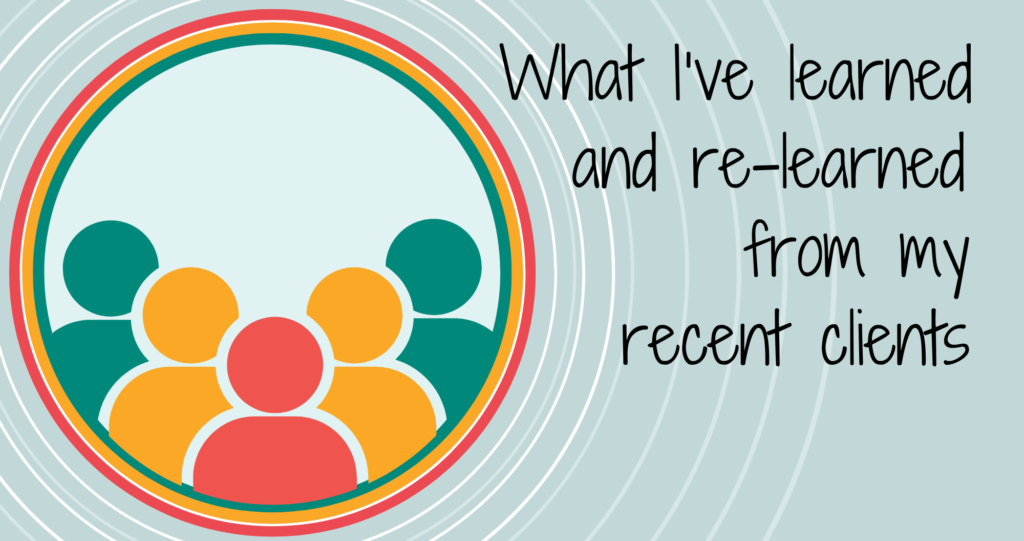Over the last few weeks, I’ve had multiple opportunities to learn and relearn very important things from clients. This blog gives me the opportunity to describe and share these, in hopes that some of what you’ll read may be useful to you in your own personal and professional work.
Learning/re-learning # 1
Accurate type identification is essential with coaching clients
One of my coaching clients, a senior manager, thought she was an Enneagram Eight, with the specific coaching issue being that her “boss” had told her she “did not read a room well” and needed to work on her interpersonal skills. After our conversation, and it didn’t take long, it became clear she was not an Eight, but a Six. In her Sixness, as she would describe it, she’s also a combination 1-1 and social subtype. Here’s why this matters so much.
What her “boss” identified as her having interpersonal problems and not being able to “read a room” was not true. It was his overgeneralized response to their interactions. In fact, her interpersonal skills were quite good and her ability to read a room was even better. The core issue was she did not get along with her “boss” because she perceived him as deceptive and abusive. Although this might bother anyone, it was especially triggering to her as a Six. She would react aggressively without a pause, speak on behalf of the team (even when not asked to do so) in team meetings, and all of this got her in trouble with her boss. These issues and reactions are type Six, not type Eight, and were much easier to deal with once she understood her type Six triggers and subsequent responses. It was also a relief for her to recognize that her interpersonal skills were actually quite good, as this is also how she perceived herself. It’s hard to work on issues in terms of type when there isn’t really an issue or when the issues are not accurately identified and understood.
Learning/re-learning # 2
Teaching subtypes accurately is not that difficult
We can make teaching subtypes hard by explaining too much all at once, our not understanding the subtypes accurately, and making them more complex than they really are. But the big issue I’ve seen over and over was brought to light once again during my recent Singapore Team Transformations program. In this group of nearly 40 people, about 80% thought they knew their subtypes and for 50% of these participants, their subtype identification turned out to be wrong. The remaining participants did not know much about subtypes, and they were easier to teach. In about one hour, everyone understood their subtype(s) accurately except for one person who was really quite new to self-awareness. I taught the subtypes using our training tool, the 27 Enneagram Subtypes, which has graphical icons and short descriptions of each subtype.
During this process, I relearned that one of the biggest obstacles to understanding and identifying subtypes accurately is this: the conflation of instincts with subtypes. Instincts and subtypes are not the same, yet many people get taught or think that they are identical. The three instincts – self-preservation, social and one-to-one (aka sexual or intimacy) – are the three basic human instincts that we all have. Ideally, we get our real needs met in each of those areas.
The 9 passions, one that goes with each type, are the emotional habits or engines of each type, but they are also not the subtype. However, when one or more instincts that are active (agitated) in a person combine or intersect with the passion of that type, the three different subtypes emerge. Understood this way, the passion-instinct intersection distorts the instinct so that the person is no longer in touch with their real needs in that instinctual area.
It is so important to clearly delineate instincts from subtypes and to also not refer to the subtypes as instincts, which some people do as a form of shorthand – equating subtypes with instincts. However, doing so obscures the ability of people to truly understand the meaning of subtypes.
Learning/re-learning # 3
We can use just about anything for our growth
Whether it is cleaning (or not cleaning) the house, deciding what and where to eat, or responding to something that occurs in our environment that feels like a big deal to us, type always emerges. But do we notice this and do we use it for our own development?
Here is an example from a colleague who was four days from launching her first book. A type Three, she was even more focused on planning than most and just as excited as anyone would be. Four days before the book launch, Facebook took down all of her accounts, including Instagram, with no warning, no explanation, and no information about when these would be reinstated. Plans were thwarted indefinitely, a seeming disaster for any new book author, but especially for a Three with goals and plans.
Of course, she tried to problem-solve the situation, but to no avail. What did she do instead? Instead of focusing on her thwarted plans, she used the experience to explore her strong attachment to them and what she could learn about herself to relax them more. What were the messages about her ego structure? What in her response did not serve her in this situation? How could she use the time she had allocated to her book launch for other purposes: her own development, other creative projects she was eager to start, and more? As she said, “I learned not to get ahead of my skis, but to sit on top of them, centered and balanced.” Hurray!
Ginger Lapid-Bogda PhD, author of nine Enneagram books, is a speaker, consultant, trainer, and coach. She provides certification programs and training tools for business professionals around the world who want to bring the Enneagram into organizations with high-impact business applications. TheEnneagramInBusiness.com | ginger@theenneagraminbusiness.com


Comments are closed.